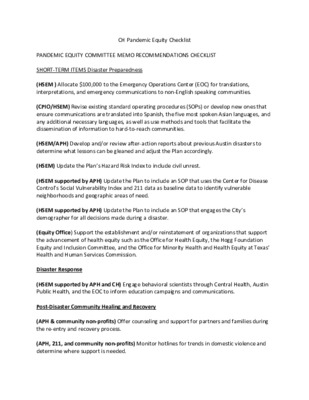Backup — original pdf
Backup

CH Pandemic Equity Checklist PANDEMIC EQUITY COMMITTEE MEMO RECOMMENDATIONS CHECKLIST SHORT‐TERM ITEMS Disaster Preparedness (HSEM ) Allocate $100,000 to the Emergency Operations Center (EOC) for translations, interpretations, and emergency communications to non‐English speaking communities. (CPIO/HSEM) Revise existing standard operating procedures (SOPs) or develop new ones that ensure communications are translated into Spanish, the five most spoken Asian languages, and any additional necessary languages, as well as use methods and tools that facilitate the dissemination of information to hard‐to‐reach communities. (HSEM/APH) Develop and/or review after‐action reports about previous Austin disasters to determine what lessons can be gleaned and adjust the Plan accordingly. (HSEM) Update the Plan’s Hazard Risk Index to include civil unrest. (HSEM supported by APH) Update the Plan to include an SOP that uses the Center for Disease Control’s Social Vulnerability Index and 211 data as baseline data to identify vulnerable neighborhoods and geographic areas of need. (HSEM supported by APH) Update the Plan to include an SOP that engages the City’s demographer for all decisions made during a disaster. (Equity Office) Support the establishment and/or reinstatement of organizations that support the advancement of health equity such as the Office for Health Equity, the Hogg Foundation Equity and Inclusion Committee, and the Office for Minority Health and Health Equity at Texas’ Health and Human Services Commission. Disaster Response (HSEM supported by APH and CH) Engage behavioral scientists through Central Health, Austin Public Health, and the EOC to inform education campaigns and communications. Post‐Disaster Community Healing and Recovery (APH & community non‐profits) Offer counseling and support for partners and families during the re‐entry and recovery process. (APH, 211, and community non‐profits) Monitor hotlines for trends in domestic violence and determine where support is needed. 1 MEDIUM‐TERM ITEMS Disaster Preparedness (CPIO, Equity Office, HSEM) Develop a process for the Plan to be reviewed by community‐ based organizations (CBOs). (CPIO, Equity Office, HSEM) Update the Plan to include an SOP that allocates funds towards stipends and paid training for CBOs and community members to learn how the EOC works. ( Equity Office, HSEM, APH) Center equity in the Plan’s Hazard Risk Index’s prioritization model. (APH, HSE) Broaden the Plan’s Hazard Risk Index to include other possible hazards. (Equity Office, HSEM, AP) Develop localized emergency response plans for neighborhoods/areas that frequently face disasters and work cooperatively with stakeholders in those areas. Identify an independent party who will review and assess the EOC’s response to: after‐action self‐assessments, incorporate community feedback, and Winter Storm Review Task Force recommendations. (APH, Equity Office) Standardize data collection, analysis, and presentation across all levels of government, including city, state, and federal governments. (APH, Equity Office Include more granular data such as race and ethnicity, primary language, disability, sexual orientation, gender identity, and social/behavioral risk factors. (CPIO, HSEM)Engage translators/interpreters and culturally sensitive/affirming workers. (Equity Office)Solidify a partnership with the Quality of Life Advisory Commissions for review and translation of culturally sensitive data and educational materials. (APH, Equity Office) Partner with Historically Black Colleges and Universities and Hispanic‐ Serving and Minority Serving Institutions. (HSEM, APH, Equity Office) Disaster Response Ensure designated community voices are activated at the beginning of a disaster response to inform the process at the highest level of the Incident Command System. Post‐Disaster Community Healing and Recovery Develop an Austin‐Travis County plan to address domestic violence. (HSEM)Coordinate with Travis County’s Attorney to align strategies and disseminate information and resources appropriately through Austin‐Travis County to avoid redundancies. LONG‐TERM ITEMS Disaster Preparedness (City Management,Council, HSEM) Update the Plan to include a long‐term goal to establish a dedicated emergency funding stream for providers during a disaster. Address and eliminate all internal barriers to data collection. Post‐Disaster Community Healing and Recovery Ensure the City of Austin’s Office of Violence Prevention and domestic violence shelters 2 are adequately funded and equipped to equitably provide resources to the community and launch a perpetual messaging campaign. Address mental health and substance use. Address the capacity limitation and need for mental health services.